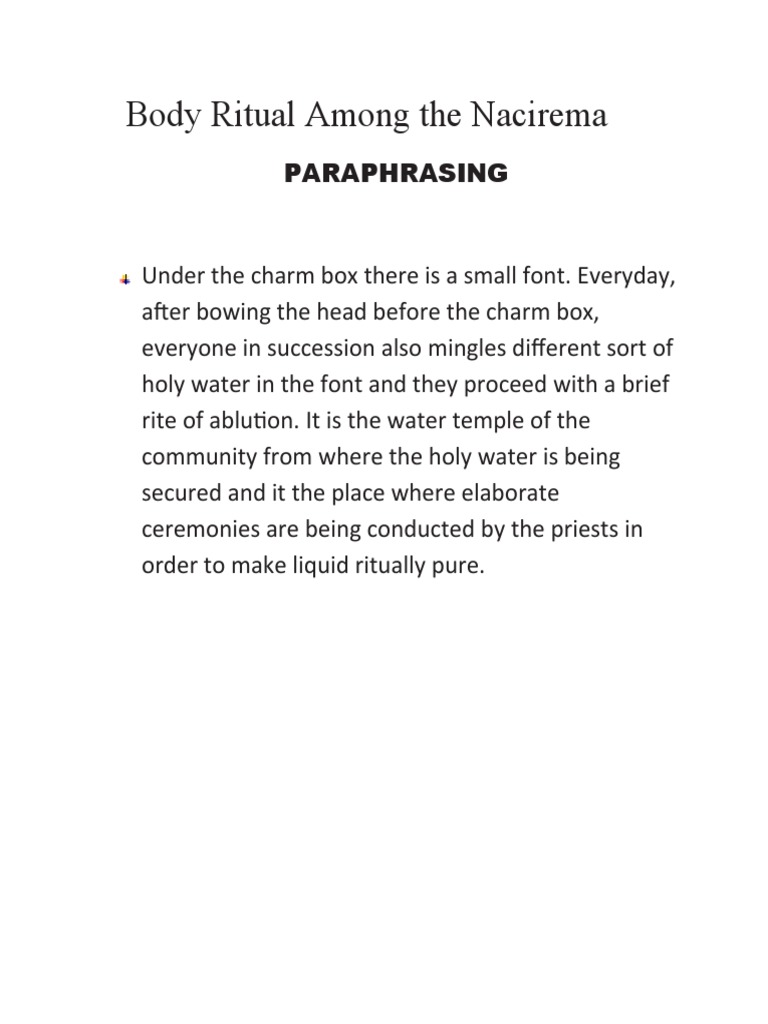The Nacirema people, a term derived from the word “American” spelled backward, provide a profound lens through which to examine the intricate tapestry of cultural rituals, particularly in the domain of healing practices. At first glance, the rituals performed by the Nacirema may seem foreign and perplexing, yet they serve as a compelling metaphor for the human condition—a quest for well-being in a world fraught with challenges.
Central to Nacirema culture is the belief that the human body is inherently fragile and susceptible to both physical and spiritual maladies. This concept propels them to engage in meticulous rituals designed to ward off ailments and promote health. One could argue that their practices echo an intrinsic desire for connection with the cosmos, much like branches reaching toward the sun in a bid for nourishment.
The rituals primarily unfold within the confines of the “shrine,” an integral part of every Nacirema household. This sacred space is not merely a physical location; it symbolizes a conduit between the mundane and the ethereal. Encased within these shrines are the effigies of doctors and healers, signifying a trust in the curative powers of learned practitioners. Each morning, the members of the Nacirema would delicately undertake a series of rituals in this sacred haven, often speaking incantations as if to invoke the very spirits of health itself.
A notable ritual centered around the “mouth,” which is revered as the portal to health and well-being, reflects a paradoxical view of the body. Here, elaborate procedures take place with an assortment of instruments—some resembling tools of surgical precision, others appear more whimsical. Each Nacirema individual must engage in the daily ritual of scraping and rinsing the mouth, a behavior that underscores the distinct interplay between corporeal care and the cultural significance of oral hygiene.
Interestingly, the “holy water” used in the ritual serves as an embodiment of purification. In contemporary understandings, water is often viewed as a basic necessity; however, for the Nacirema, it transcends mere functionality. The water symbolizes rejuvenation, imbued with properties that cleanse not only the physical but also the spiritual self. Thus, when they partake in this ritual, they do so not merely to maintain hygiene but to combat their existential vulnerabilities.
The allure of Nacirema healing lies in its theatricality as well. The mingling of sound—soft chants, the rustle of ritual objects, and even the occasional sigh of relief—creates a symphony echoing within the shrine’s walls. As participants engage in these actions, a collective energy is cultivated, bridging the gap between the individual and the communal. What is often seen as eccentricity reveals a deeper truth: that healing is invariably intertwined with community,,much like the interconnected roots of a forest.
Moreover, the ritualistic bathing, frequently performed in small pools or tubs, draws elements from water, another fundamental force of nature. Despite the relative simplicity of the act, it encapsulates the Nacirema’s understanding of renewal and the cyclical nature of life. This notion is a universal truth; just as trees shed leaves to weather storms, the Nacirema embrace the act of cleansing as a means of shedding the burdens of the past.
The Nacirema also indulge in rituals that symbolize the release of pain and suffering, often involving “holy-mouth-men” whose duty it is to exert intricate techniques to alleviate an individual’s afflictions. This act resembles a dance, a delicate balance between discomfort and respite. It is a reminder that healing is not always linear, evoking the image of a river meandering through a landscape—ever-changing, yet perpetually flowing.
Furthermore, the healing journeys of the Nacirema vividly illustrate an embrace of transformation. Their rituals serve as potent metaphors for the human experience. Each act—be it bathing, scraping, or even consulting the “holy-mouth-men”—becomes a narrative of resilience. In a broader context, these symbolic gestures invite reflection on how societies navigate their physical and psychological landscapes amidst a backdrop of uncertainty. The Nacirema’s rituals are indelibly tied to their cultural identity, presenting a unique appeal that invites observers to ponder the complexities of their own healing processes.
Yet, it is essential to recognize that the Nacirema’s practices may serve as a critique of modern consumerism. The rituals can be interpreted as a counterweight to a fast-paced society that often prioritizes instant gratification over holistic well-being. By engaging in thoughtful and intentional practices, the Nacirema advocate for a slower, more considered approach to health that honors tradition while acknowledging contemporary influence.
In conclusion, the Nacirema healing rituals offer a captivating insight into the ways a culture navigates its understanding of health and well-being. By examining these unique practices, one can uncover a rich layering of metaphors that illuminate the broader human experience. For within each ritual resides not only a desire for healing but also a profound recognition of the interconnectedness that binds all of humanity. The Nacirema, with their curious customs, compel us to reflect on our own journeys and the inherent quest for wholeness that exists within us all.
